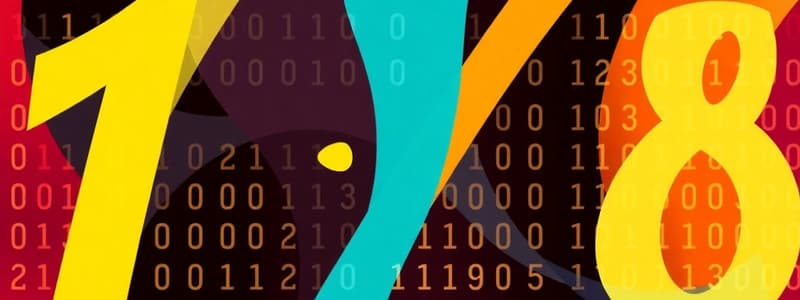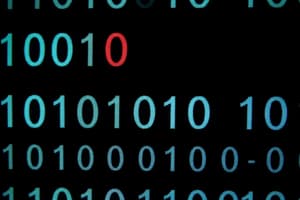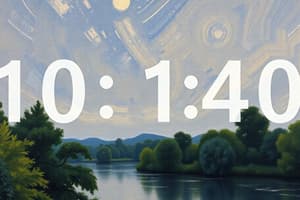Podcast
Questions and Answers
How is the Two’s Complement of a binary number derived from its One’s Complement?
How is the Two’s Complement of a binary number derived from its One’s Complement?
- By adding 1 (correct)
- By multiplying by 2
- By adding 0
- By subtracting 1
Which of the following is true about the hexadecimal system?
Which of the following is true about the hexadecimal system?
- It contains digits from 0 to 9 and letters A to F. (correct)
- It is equivalent to the binary system.
- It is a base 10 system.
- It is a base 8 system.
What represents a single unit of data in binary terms?
What represents a single unit of data in binary terms?
- Byte
- Nibble
- Bit (correct)
- Kilobyte
In the context of binary prefixes, what is a byte typically composed of?
In the context of binary prefixes, what is a byte typically composed of?
What is the decimal equivalent of the hexadecimal number 2AF?
What is the decimal equivalent of the hexadecimal number 2AF?
Which of the following correctly describes One’s Complement?
Which of the following correctly describes One’s Complement?
What is the correct weight for the leftmost bit in an 8-bit binary number?
What is the correct weight for the leftmost bit in an 8-bit binary number?
What is the base of the binary number system?
What is the base of the binary number system?
How is a binary number converted to its decimal equivalent?
How is a binary number converted to its decimal equivalent?
What does the most significant bit indicate in One’s Complement representation?
What does the most significant bit indicate in One’s Complement representation?
Which of the following correctly describes the One’s Complement method?
Which of the following correctly describes the One’s Complement method?
What is the primary challenge when representing negative binary numbers?
What is the primary challenge when representing negative binary numbers?
In a binary number, what is the positional weight of the leftmost digit in 8 bits?
In a binary number, what is the positional weight of the leftmost digit in 8 bits?
What happens to the value of a binary number when converting it to One’s Complement?
What happens to the value of a binary number when converting it to One’s Complement?
Which method is NOT used for representing negative binary numbers?
Which method is NOT used for representing negative binary numbers?
What is the binary representation for the decimal number 316?
What is the binary representation for the decimal number 316?
Which aspect of binary coding allows computers to understand electrical states?
Which aspect of binary coding allows computers to understand electrical states?
What does ASCII stand for?
What does ASCII stand for?
What limitation of ASCII led to the development of UNICODE?
What limitation of ASCII led to the development of UNICODE?
How does UNICODE ensure compatibility with ASCII?
How does UNICODE ensure compatibility with ASCII?
What does Binary Coded Decimal (BCD) specifically represent?
What does Binary Coded Decimal (BCD) specifically represent?
Which of the following statements is true about the ASCII coding system?
Which of the following statements is true about the ASCII coding system?
What is the decimal value of the binary number 10100101 using One’s Complement?
What is the decimal value of the binary number 10100101 using One’s Complement?
In binary representation, what is the role of bits?
In binary representation, what is the role of bits?
What is the hexadecimal equivalent of the decimal number 687?
What is the hexadecimal equivalent of the decimal number 687?
How many bits are there in a byte?
How many bits are there in a byte?
What represents the highest digit in the hexadecimal system?
What represents the highest digit in the hexadecimal system?
Which statement is true regarding binary prefixes?
Which statement is true regarding binary prefixes?
How many digits does the hexadecimal system use to represent values?
How many digits does the hexadecimal system use to represent values?
What is the primary digit system used in computing?
What is the primary digit system used in computing?
How is the decimal equivalent of the binary number 01101110 calculated?
How is the decimal equivalent of the binary number 01101110 calculated?
In One’s Complement representation, what happens to each digit of the binary number?
In One’s Complement representation, what happens to each digit of the binary number?
What indicates the sign of a number in One’s Complement representation?
What indicates the sign of a number in One’s Complement representation?
What does the leftmost bit in an 8-bit binary number represent?
What does the leftmost bit in an 8-bit binary number represent?
How can a binary number be converted to its decimal equivalent?
How can a binary number be converted to its decimal equivalent?
What is the weight of the leftmost bit in a binary number containing 8 bits?
What is the weight of the leftmost bit in a binary number containing 8 bits?
What does the acronym ASCII stand for?
What does the acronym ASCII stand for?
Which hexadecimal number correctly converts to decimal as demonstrated?
Which hexadecimal number correctly converts to decimal as demonstrated?
Which statement about UNICODE is true?
Which statement about UNICODE is true?
What is the primary use of Binary Coded Decimal (BCD)?
What is the primary use of Binary Coded Decimal (BCD)?
What limitation of ASCII led to its development into UNICODE?
What limitation of ASCII led to its development into UNICODE?
How is the Binary Coded Decimal for the number 316 represented?
How is the Binary Coded Decimal for the number 316 represented?
What is the role of the most significant bit in binary representation?
What is the role of the most significant bit in binary representation?
How does UNICODE represent new symbols?
How does UNICODE represent new symbols?
Flashcards
Binary System
Binary System
A numerical system that uses only two digits, 0 and 1, to represent any number. Each digit's position determines its value.
Decimal System
Decimal System
A numerical system with a base of 10, using digits 0 through 9. The position of each digit determines its value.
Two's Complement
Two's Complement
A method for representing negative binary numbers by inverting all the bits (changing 0s to 1s and 1s to 0s) and then adding 1.
One's Complement
One's Complement
Signup and view all the flashcards
Positional Weight
Positional Weight
Signup and view all the flashcards
Binary to Decimal Conversion
Binary to Decimal Conversion
Signup and view all the flashcards
Prefixes in Computer Science
Prefixes in Computer Science
Signup and view all the flashcards
Character Encoding
Character Encoding
Signup and view all the flashcards
Byte
Byte
Signup and view all the flashcards
Binary Prefixes
Binary Prefixes
Signup and view all the flashcards
Hexadecimal Number System
Hexadecimal Number System
Signup and view all the flashcards
Hexadecimal to Decimal Conversion
Hexadecimal to Decimal Conversion
Signup and view all the flashcards
Binary Coded Decimal (BCD)
Binary Coded Decimal (BCD)
Signup and view all the flashcards
ASCII (American Standard Code for Information Interchange)
ASCII (American Standard Code for Information Interchange)
Signup and view all the flashcards
Unicode
Unicode
Signup and view all the flashcards
Data Representation
Data Representation
Signup and view all the flashcards
Data Conversion
Data Conversion
Signup and view all the flashcards
Hexadecimal System
Hexadecimal System
Signup and view all the flashcards
Study Notes
Data Representation
- This presentation covers different number systems, including methods for converting between them.
- Decimal is the base-10 system used in daily life.
- Binary uses base-2 (0s and 1s), crucial in computer systems.
- Prefixes denote magnitudes in both base-10 and base-2 systems.
- Example base-10 prefixes: Kilo (1000), Mega (1,000,000).
- Example base-2 prefixes: Kibi (1024), Mebi (1,048,576), Gibi (1,073,741,824), Tebi (1,099,511,627,776), Pebi (1,125,899,906,842,624).
- Converting from binary to decimal involves multiplying each binary digit by the corresponding power of 2 and summing the results.
- One's Complement and Two's Complement represent negative binary numbers.
- One's Complement inverts the bits.
- Two's Complement adds 1 to the One's Complement.
- The leftmost bit (most significant bit) in a binary representation indicates the sign.
- 0 for positive, 1 for negative in the Two's Complement system.
- Hexadecimal uses base-16, combining digits 0-9 and letters A-F.
- Each hexadecimal digit corresponds to a 4-bit binary sequence.
- Example: 2AF (hexadecimal) is equivalent to 687 (decimal).
- Binary Coded Decimal (BCD) uses 4 bits per each decimal digit.
- 0000 = 0, 0001=1, 0010=2... 1001=9.
- ASCII (American Standard Code for Information Interchange) and Unicode map characters to numerical values.
- ASCII has 127 characters.
- Unicode extends this, supporting a wider range of characters and symbols.
Studying That Suits You
Use AI to generate personalized quizzes and flashcards to suit your learning preferences.




